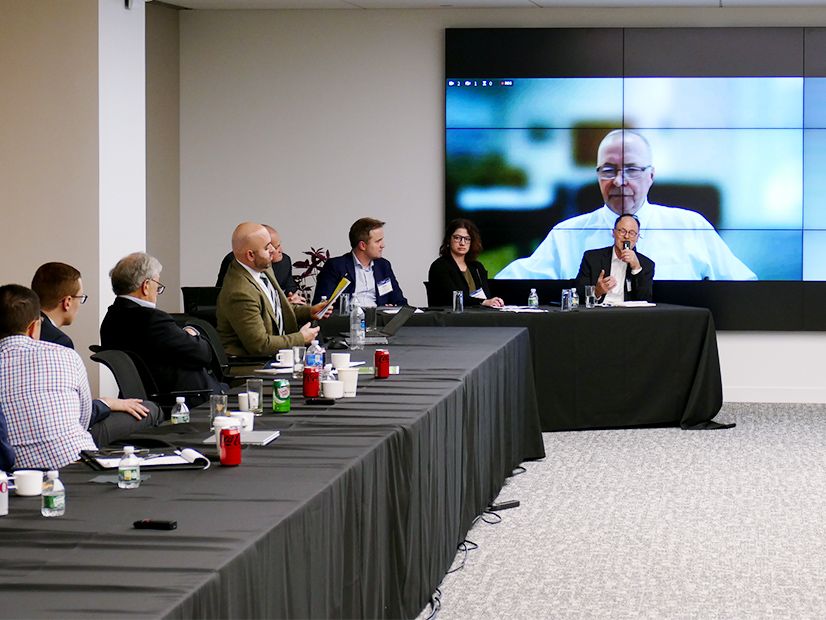
The U.S. economy is experiencing its first taste of high inflation in decades, and that is contributing to delays in new renewable power projects, experts told the Energy Bar Association Northeast Chapter’s Winter Summit on Wednesday.
The 1970s was the last time U.S. industry had to deal with very serious inflation, and it led to major changes in the regulation of the power sector, said the Brattle Group’s Peter Fox-Penner.
This round of inflation seems to be less serious than that of the 1970s, he said. “But it’s still a profoundly impactful one, and the first one in 30 years — in a very, very different industry.”
The two key characteristics of whether industries are impacted by inflation is their ability to set prices and how capital-intensive they are, said 18th Square Managing Member Walter Hopkins, who has advised offshore wind developers on how to bid for power purchase agreements.
Offshore wind farms involve huge upfront investments, which are only estimates when they bid for a contract, and that is paid for by long-term contracts that are include some elements of fixed price.
“Winning an offshore wind project in 2021, for instance, is a bit like if you agreed to pay for a bond that would give you a fixed stream of revenue,” Hopkins said. “But you didn’t know what the price was; you’re going to pay for the bond; and you’re going to have to pay for it a couple years later after inflation kicked in, and the costs of the project rise with inflation.”
That model used to work in the industry, as developers would sign a contract and then benefit from the declining costs of turbines, but with rising costs across the board to build anything, that is no longer the case, he added.
Eversource Energy (NYSE:ES) has signed contracts for offshore wind that are meant to see delivery start later this decade, said its vice president of energy supply, James Daly.
“It’s public information that a number of these projects have stated that they cannot close financing on their current contract prices,” Daly said. “So not surprisingly, developers are citing supply chain, interest rates, commodity and labor costs, as well as uncertainty on regulations stemming from, believe it or not, the Inflation Reduction Act.”
The IRA is meant to offer renewable projects more generous subsidies, but it is still unclear exactly how the law will be implemented, and that adds to uncertainty on project’s ultimate costs, he added.
Massachusetts offshore wind farms have asked the Department of Public Utilities to either change or let them out of contracts they have signed with Eversource and other utilities. Commonwealth Wind, a 1,232-MW project owned by Avangrid, has said it cannot make the deal it signed work and wants to rebid in a new round. Other wind farms have said they face the same challenges because of inflation.
The Mayflower Wind Project, a joint venture between Shell and Ocean Winds (another jointly owned firm from EDP Renewables and ENGIE), won changes for a contract for 804 MW it signed with Eversource and other utilities in a DPU order issued Dec. 30. The project is changing its point of interconnection to the retired Brayton Point Plant and locking in a 30% investment tax credit.
Eversource is not that interested in repricing contracts now, which would only serve to lock in high prices, said Daly. Doing so would be similar to what California did during its energy crisis, when the state signed many high-priced deals to secure supplies to stop rolling blackouts, and that led to decades of litigation, he added.
“It will take some time to work through this, [but] we are seeing a turning of a corner,” said Daly.
Inflation seems to be slowing, supply chains are working themselves out, and the technology is still improving with developers able to use larger, more efficient turbines to build the wind farms than they initially planned for, he added. But some adjustments to state policy might be needed to reflect the new, harsher economic reality.
“When the current targets were set, there was no COVID on the horizon,” said Daly. “And since then we’ve had fairly significant supply chain disruptions.”
Cogentrix Energy Power Management Vice President of Regulatory Affairs Christopher Sherman agreed. His company, a subsidiary of the investment firm the Carlyle Group, owns natural gas plants but is increasingly focused on developing storage.
The largest storage projects Cogentrix is developing are about 400 MW, but they will not be ready to connect to the grid for four years, he said.
“And yet in some of those markets, the state policy pressure is to close those dispatchable resources before that,” Sherman said. “So ultimately, probably what happens is you have increased consumer cost, and you possibly have reliability issues.”
The time frame for some of the transition away from traditional, dispatchable generation needs to be adjusted to reflect the current market conditions, he added.


